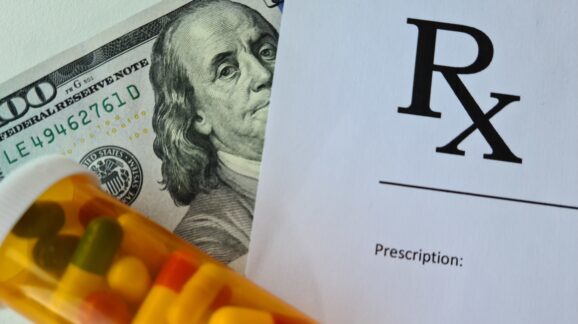The TrumpRx medicine will prove worse than the disease

Photo Credit: Getty
On September 30, President Trump, standing alongside the CEO of Pfizer, announced a multifaceted deal wherein Pfizer would inoculate itself from new regulations and taxes, including tariffs, that the president threatened to impose. AstraZeneca announced its own agreement on October 10. President Trump’s objectives—to secure lower prices on pharmaceuticals for the American people and compel other countries to contribute more to research—may be benevolent, but they will nonetheless come at a high cost eventually.
The deals’ terms have not been revealed in their entirety yet, as many of them are likely still being developed. Three major pieces merit scrutiny: First, both Pfizer and AstraZeneca will be selling some of their products directly to consumers, through a portal run by the US government. It is currently deemed TrumpRx, but it is unclear if that will remain as its official name. TrumpRx will list the drugs available along with their prices. It will redirect consumers to the manufacturer’s website for purchase. Pfizer has claimed that prices on the TrumpRx platform will be significantly below the list price of the drugs, as high as an 85 percent discount but 50 percent on average.
Second, both Pfizer and AstraZeneca commit to selling all of their drugs to states’ Medicaid programs at the “Most Favored Nation (MFN) price”, i.e., the lowest price that drug is for sale in developed countries outside of the US. There have been many arguments against using this price scheme, but both firms have agreed to using it for Medicaid. Given drug companies already sell drugs to Medicaid at a discount, the potential financial cost of this is low.
The largest potential financial cost comes from the third element of the arrangement—Pfizer committing to offer new drugs at the MFN price. Currently, it is unclear whether AstraZeneca has made this commitment. Drug companies typically earn large profits from new drugs. This, therefore, is seemingly a commitment to reduce all prices across the board and set their prices to the lowest prevailing price in countries that set prices by fiat, including those with socialized medicine. This would be a substantial departure from American practice.
For Pfizer to agree to these concessions, it must be getting something of value in return. Indeed, the market thinks that Pfizer is getting the much better end of the deal, as its stock shot up 14 percent over the next two days, while the rest of the market rose by less than 1 percent over the same period.
Pfizer and AstraZeneca’s gain can be attributed to two components. First, they secured a three-year “grace period” from Trump’s Section 232 investigation into pharmaceuticals, which threatened to increase tariffs on highly profitable, brand name pharmaceuticals considerably. This investigation is still ongoing and can theoretically conclude that tariffs of any amount are necessary on pharmaceuticals. Section 232 gives the president extensive discretion on what products to tariff and what that tariff can be. The Section 232 process puts tariffs imposed by the president on firmer ground than the process he’s used for his nation-by-nation tariffs. A three-year exemption from whatever rate the administration decides on as well as from the uncertainty is extremely valuable.
Additionally, they will both avoid several other executive actions President Trump threatened to take that would compel the drug companies to lower their prices. These threats included using the Federal Food, Drug, and Cosmetic Act to individually assess the safety of each imported drug and then grant exemptions on a case-by-case basis. The administration also indicated it would direct the Federal Trade Commission to carefully assess the drug manufacturers’ behavior and look for anticompetitive practices. In addition, it directed the Secretary of Commerce, the Commissioner of Food and Drugs, and the Assistant to the President for Domestic Policy to doggedly pursue these companies and find any and all violations they were committing under the full regulatory code of the United States if they didn’t lower their prices to match those of foreign countries.
Essentially, by committing to participate in TrumpRx, Pfizer and AstraZeneca have given in on pricing. In return, the president has committed to limit the tariffs imposed on their products and refrain from using the executive branch to go after their companies.
Judging only by immediate consequences, it seems like a win-win. The companies keep developing and selling drugs, even making some of them in the US, and start offering them at lower prices, and President Trump gets to celebrate a victory for Americans. What this happy outcome hides, though, are the incentives it creates for the future and the additional powers that corporations have just recognized.
Perhaps Trump will stop after this win. Given his history, that could go either way. The more concerning problem is what his successor will do with the knowledge that threatening companies works. Will the next president want to out-Trump Trump and actually extort companies for even further reduced drug prices, unilaterally shifting the industry to be lower profit and less innovative? Perhaps a future Democratic president will threaten to break up the drug companies unless they provide drugs to Medicare and Medicaid and the new public option at a loss.
If TrumpRx is a big success and more people buy their drugs through it, it will give the government even more leverage to compel drug companies to meet their policy demands. Drug research and manufacturing will need to be ESG-complaint, carbon-neutral, and DEI-adherent. Pills will need to be dyed to be more diverse and representative of America. And the pharmacies we know and who know us and our needs will be replaced by government bureaucracy.
Americans might be happy that Trump has jawboned his way to one positive outcome—a lower price, offered voluntarily with only minor downsides; and companies and their shareholders may be glad they dodged a bigger bullet. However, giving in to government threats for short-term relief paves the way for bigger demands and more pain in the long run.